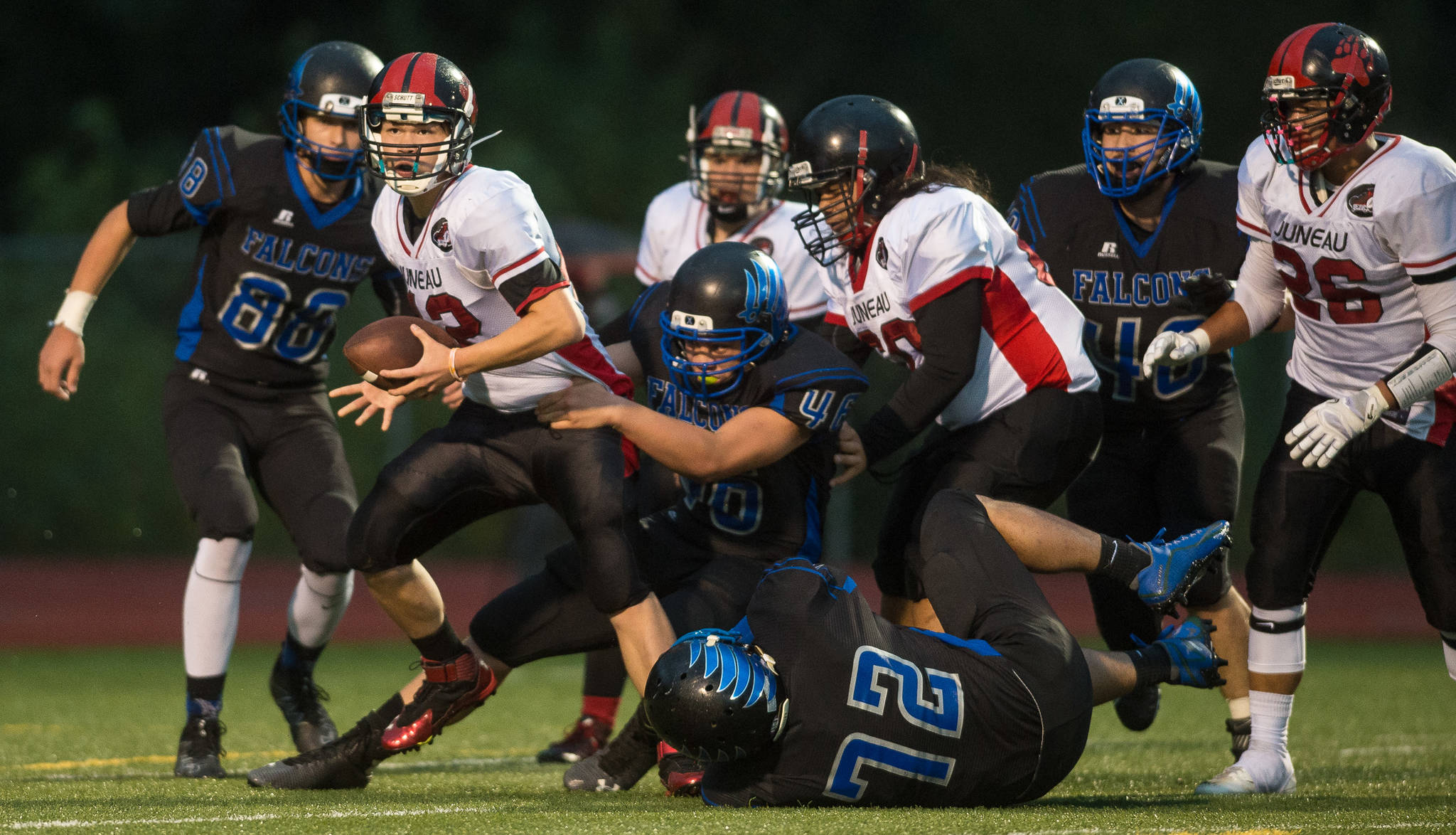The Alaska School Activities Association has given the Juneau School District until Nov. 1 to submit a written proposal regarding a cooperative, or merged, Thunder Mountain and Juneau-Douglas football team.
“The conversation is happening, we’re very close to a decision one way or another,” Thunder Mountain High School Athletic Director Jake Jacoby said. “I would say in the next week a final decision will be made.”
Football is one of the sports that has generated the most discussion on whether to merge. Finding it difficult to consistently maintain a healthy checkbook and roster, the Juneau programs could find immediate benefits to merging into one team.
Thunder Mountain High School opened in 2008 and established its football program the following year. Several years later, Juneau-Douglas High School moved from a 4A, or Division I school, to a 3A, or Division II school.
Getting ASAA’s attention (if needed)
All proposals brought to the ASAA Board of Directors must first pass through the board of the affected region — in this case, Region V.
Jacoby broached the topic of consolidating their two football teams at a September meeting with the Region V Board Members.
“We discussed the potential, the possibility,” Jacoby said. “Everyone seems to understand where we’re coming from — where we’re coming from financially, also just competitively and the safety concerns of so many freshmen playing, especially on JD’s team that’s been so low on numbers lately. There wasn’t any negativity that came out of that meeting.”
Should the two teams become one, Ketchikan would, as Jacoby puts it, be left on “an island as a medium school football team.”
North Pole — one of four Southeast Conference members — has already elected to join a large schools conference next season. A potential cooperative team between JDHS and TMHS would give them a large enough student body to count them as a large school or Division I team.
ASAA Associate Director Sandi Wagner said it usually takes at least two meetings for proposals to be dealt with.
While Juneau teams are especially susceptible to cuts to school district funding due to high travel costs in and out of the region, Wagner noted Juneau’s predicament is part of a statewide trend.
“This is just, unfortunately, the state of Alaska,” Wagner said. “There have been co-ops all over the place for a very long time because they didn’t have enough kids. The co-ops that are coming out now are completely dealing with cost. It’s a cost issue. They can’t afford it.”
JSD did not provide activities funding outside of administrative costs this fiscal year. JSD Director David Means said the same will be true this year.
That has placed extra pressure on local businesses to help recover some of those fees.
“There’s a lot of expenses besides the travel,” JDHS football head coach Kevin Hamrick said. “And the community has been so awesome to support all these (expenses) but I just don’t know how much longer they can keep it up because they’re starting to cut back.”
Hamrick said there was about a 25 percent drop in business sponsorships from this season to last.
Putting kids on the field
TMHS head football coach Randy Quinto declined to comment on his team’s finances but wholeheartedly agreed with Hamrick on a separate issue: the futility of playing freshman on varsity.
And while Quinto’s roster was certainly deeper this season than Hamrick’s, he still didn’t have enough to support a junior varsity.
“It really doesn’t help the football program here in Juneau at all to not have a feeder program, to have a JV that’s going to move up to your varsity,” Quinto said. “Otherwise, every year, we’re plugging guys in who have never played in those positions and that’s tough without any game experience.
“So moving to a co-op, hopefully having a JV, and being able to financially sustain a JV, those younger kids will get the (game) time and then the program can build from there.”
Over the last five years, Hamrick has watched his team go from being one touchdown away from winning a state championship (2013) to a team whose only medium schools wins came against the winless Ketchikan Kings (this year).
“Having freshmen out there on your varsity is just not common, you’re at a disadvantage,” Hamrick said. “Even though some of them have good size, their muscles aren’t as developed, etc. etc. So that’s my number one reason to support it.”
The district held an open forum in the spring to gauge the public’s opinion on the prospect of consolidating high school football and softball at the two schools.
No decisions were made one way or the other at the meeting. Polls did show that the community is still fairly split on the matter.
Hamrick hopes those wishing to maintain both teams at all costs can see the flipside of the equation — and the difficult decision facing the school administration.
“They’ll just think we’re losing a team but in fact, we’re gaining a safer event for our kids to participate in with better equipment, better competition,” he said.
Correction: An earlier version of this article incorrectly stated the ASAA handbook does not specifically provide a route for schools with over 500 students to apply for cooperative status. Article 7, Section 11.D of the ASAA Bylaws states, “The Board of Directors may also approve cooperative school programs for member schools who do not otherwise qualify…” The article has been updated to reflect the change.
• Contact sports reporter Nolin Ainsworth at 523-2272 or nolin.ainsworth@juneauempire.com.

